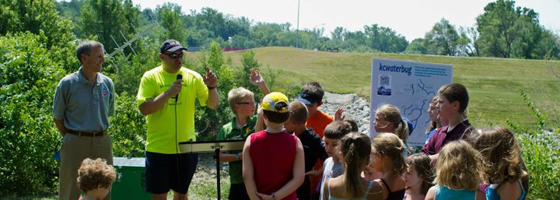KCWaterBug app relays real-time bacteria estimates

A new smartphone program is helping to keep families around Kansas City safe from possible bacteria in local streams and rivers.
The free application, called KCWaterBug, provides users with different color codes that give real-time estimates of bacteria concentrations in local streams. Users can employ the app to see how much bacteria was found in a stream during the previous hour.
“The KCWaterBug app denotes recreational activities that should be acceptable based on an estimate out of the average concentration of bacteria that might be found in the stream during the previous hour,” said Kris Lancaster, public affairs specialist for the U.S. Environmental Protection Agency.
The app includes five different colors that all represent a different level of bacteria. A blue icon means “Appropriate for all forms of recreation including swimming” while a red icon means “Contact with water is not advised.” The app also uses color to advise when only some contact in the water is appropriate or if the monitoring equipment was not able to make a reading at all.
This will allow citizens to make informed decisions regarding recreation, Lancaster said.
The app also promotes greater awareness on the water quality in the area, along with allowing citizens to take an active role in protecting the streams, according to the application.
The information is monitored by in-stream equipment and satellite technology installed by EPA staff in 2011, according to a press release from the agency.
A recent U.S. Geological Survey study conducted in Kansas shows basic water quality in urban areas has a great correlation with actual bacteria concentration, said Jeff Robichaud, deputy director of EPA Region 7 Environmental Services Division.
With that information, Robichaud and his environmental team spent the last couple years collecting paired measurements several dozen times at each of the monitoring sites.
“(We) have developed a regression equation that correlates bacteria estimated in streams versus turbidity level,” Robichaud said.
Using the information collected over the years, the team now uses satellites to get the measurements once per hour.
“We continuously (measure) additional bacteria to continually refine that equation so we ensure that we’re always giving the most accurate estimate,” Robichaud said.
There are 12 monitors throughout the area, but EPA said they plan to continue expanding the water quality project.
Six new monitors will be making their way to various streams in the area. The companion website, KCWaters.org, will include all the water quality data measured by the new monitors, Lancaster said.
Although family safety is one of the top priorities with this project, the samples are also being used for agency research, he added.
“There is a goal beyond families. States and cities work together to develop total maximum daily loads, which is pollutant reduction plans for streams,” Lancaster said.
The data recorded from the equipment will aid researchers in their plans to improve their ability to protect water quality, he added.
Robichaud said they hope the have the new monitors up and running for the public by next spring.
“This seems to be the first place in the country where this is happening, a real-time estimate of bacteria in flowing waters,” Robichaud said. “We’ve been extremely pleased.”
Photo: Jeff Robichaud, deputy director of EPA Region 7’s environmental services division visits with youth at an event announcing an expansion of water-quality monitoring of Kansas City area streams and introduction of a new App “KCWaterBug” for smartphones and mobile devices. (Credit: EPA)





0 comments